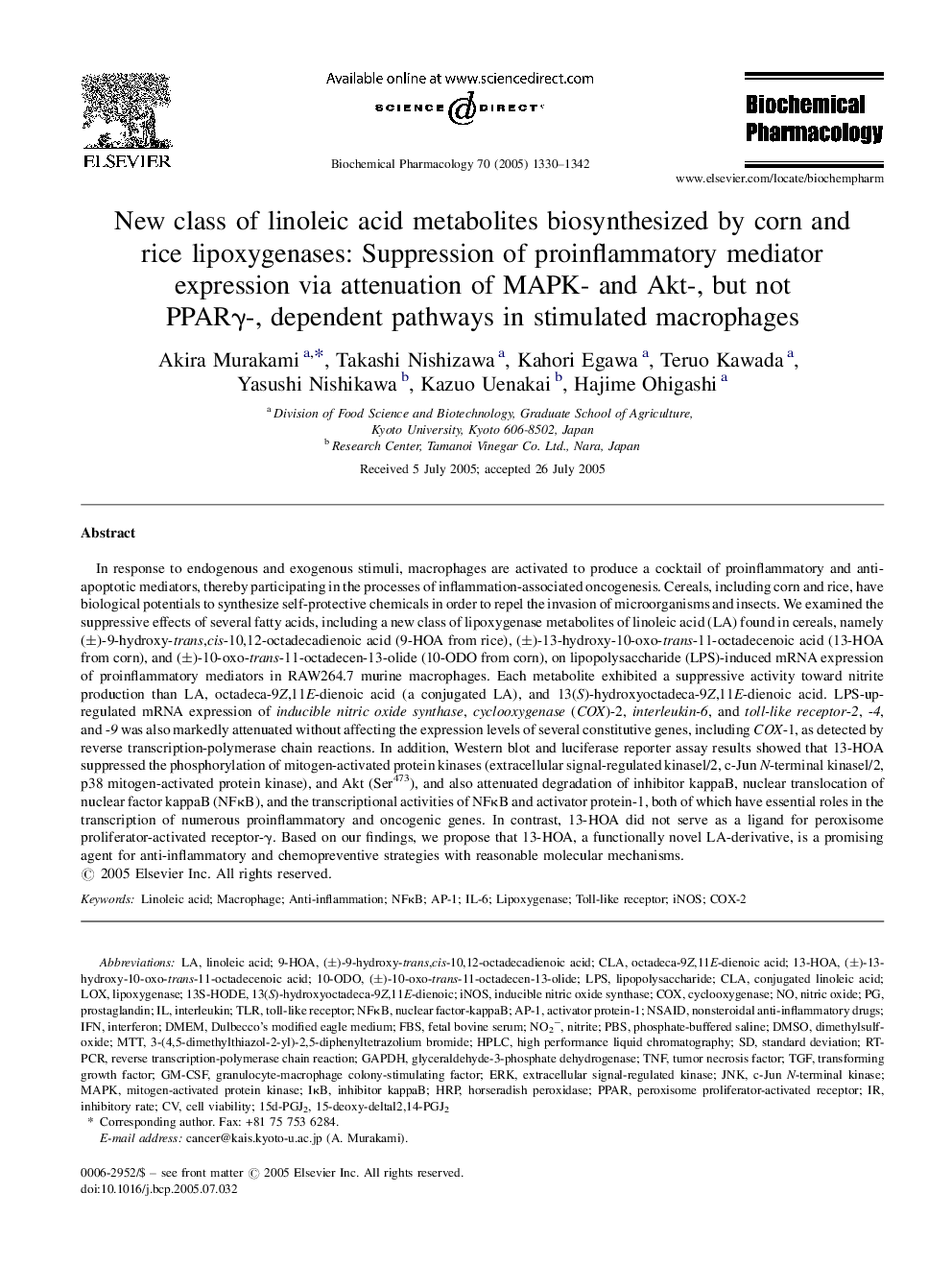| Article ID | Journal | Published Year | Pages | File Type |
|---|---|---|---|---|
| 9001632 | Biochemical Pharmacology | 2005 | 13 Pages |
Abstract
In response to endogenous and exogenous stimuli, macrophages are activated to produce a cocktail of proinflammatory and anti-apoptotic mediators, thereby participating in the processes of inflammation-associated oncogenesis. Cereals, including corn and rice, have biological potentials to synthesize self-protective chemicals in order to repel the invasion of microorganisms and insects. We examined the suppressive effects of several fatty acids, including a new class of lipoxygenase metabolites of linoleic acid (LA) found in cereals, namely (±)-9-hydroxy-trans,cis-10,12-octadecadienoic acid (9-HOA from rice), (±)-13-hydroxy-10-oxo-trans-11-octadecenoic acid (13-HOA from corn), and (±)-10-oxo-trans-11-octadecen-13-olide (10-ODO from corn), on lipopolysaccharide (LPS)-induced mRNA expression of proinflammatory mediators in RAW264.7 murine macrophages. Each metabolite exhibited a suppressive activity toward nitrite production than LA, octadeca-9Z,11E-dienoic acid (a conjugated LA), and 13(S)-hydroxyoctadeca-9Z,11E-dienoic acid. LPS-up-regulated mRNA expression of inducible nitric oxide synthase, cyclooxygenase (COX)-2, interleukin-6, and toll-like receptor-2, -4, and -9 was also markedly attenuated without affecting the expression levels of several constitutive genes, including COX-1, as detected by reverse transcription-polymerase chain reactions. In addition, Western blot and luciferase reporter assay results showed that 13-HOA suppressed the phosphorylation of mitogen-activated protein kinases (extracellular signal-regulated kinasel/2, c-Jun N-terminal kinasel/2, p38 mitogen-activated protein kinase), and Akt (Ser473), and also attenuated degradation of inhibitor kappaB, nuclear translocation of nuclear factor kappaB (NFκB), and the transcriptional activities of NFκB and activator protein-1, both of which have essential roles in the transcription of numerous proinflammatory and oncogenic genes. In contrast, 13-HOA did not serve as a ligand for peroxisome proliferator-activated receptor-γ. Based on our findings, we propose that 13-HOA, a functionally novel LA-derivative, is a promising agent for anti-inflammatory and chemopreventive strategies with reasonable molecular mechanisms.
Keywords
TGFRT-PCRERKCLACOX-2HRPGAPDHiNOSNSAIDPPARIκBAP-1TLRFBSGM-CSF13S-HODEPBSTNFLPSIL-6DMEMCOXInhibitory rate15d-PGJ2Jnk3-(4,5-dimethylthiazol-2-yl)-2,5-diphenyltetrazolium bromidec-Jun N-terminal kinaseDMSODulbecco's modified Eagle MediumMAPKMTTNFκBNO2−cyclooxygenaseLinoleic acidconjugated linoleic acidstandard deviationLOXinterferonIFNinterleukintransforming growth factorToll-like receptorNonsteroidal anti-inflammatory drugsDimethylsulfoxideCell viabilityfetal bovine seruminducible nitric oxide synthaseAnti-inflammationgranulocyte-macrophage colony-stimulating factortumor necrosis factornuclear factor-kappaBlipoxygenaselipopolysaccharideMacrophagePhosphate-buffered salineNitriteNitric oxidereverse transcription-polymerase chain reactionHorseradish peroxidaseactivator protein-1mitogen-activated protein kinaseprostaglandinhigh performance liquid chromatographyHPLCextracellular signal-regulated kinaseglyceraldehyde-3-phosphate dehydrogenaseperoxisome proliferator-activated receptor
Related Topics
Health Sciences
Pharmacology, Toxicology and Pharmaceutical Science
Pharmacology
Authors
Akira Murakami, Takashi Nishizawa, Kahori Egawa, Teruo Kawada, Yasushi Nishikawa, Kazuo Uenakai, Hajime Ohigashi,
